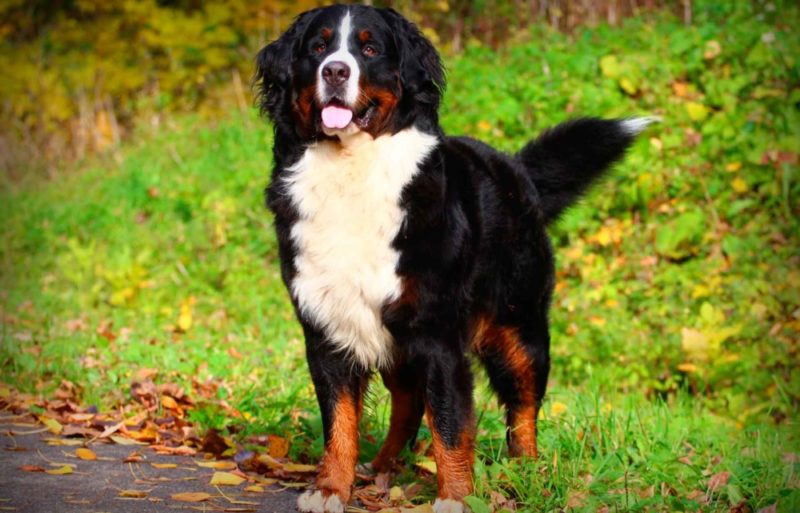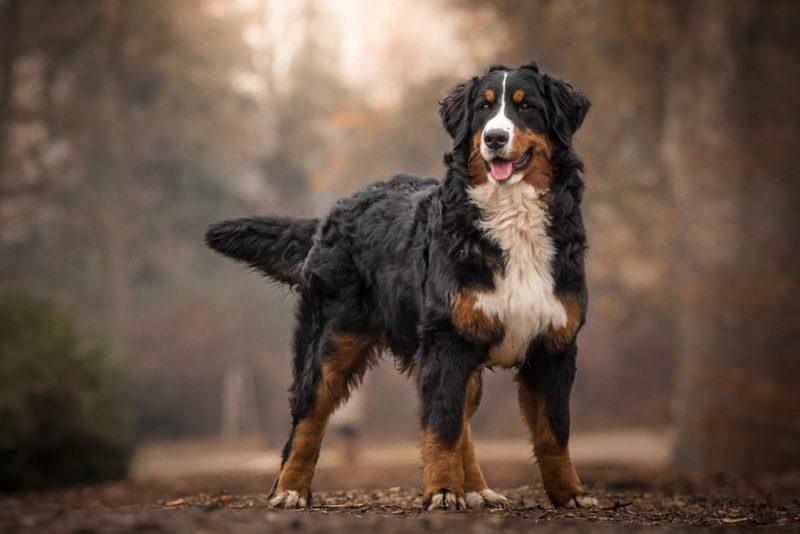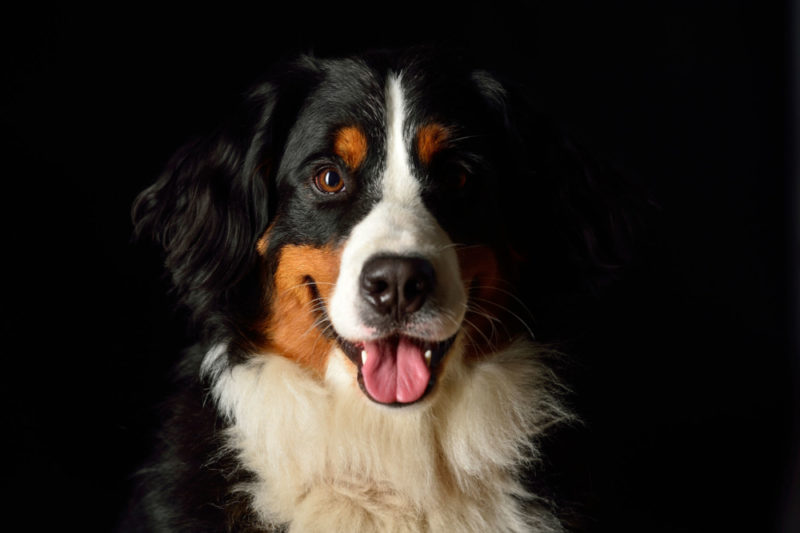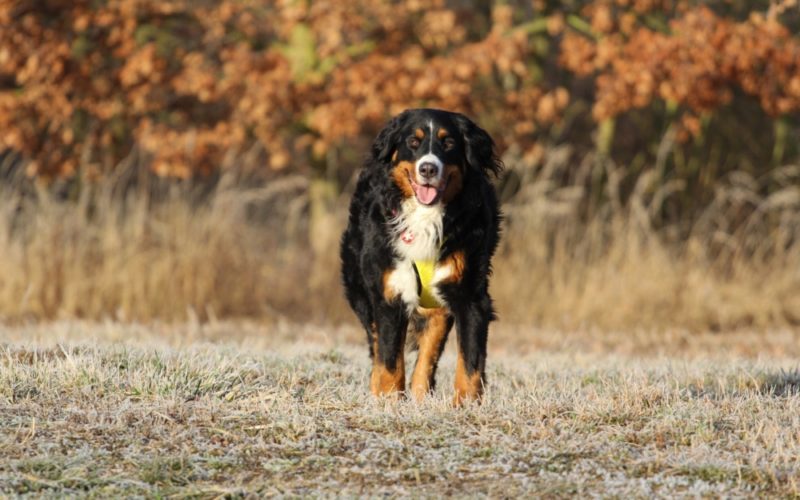Bernese Shepherd is a famous breed of Alpine shepherd dogs from Switzerland. It has evolved over the centuries. Protection and security of the occupied territory are the main responsibilities of the Bernese Mountain Dog.
Material Content:
Description and characteristics of the breed
The Bernese shepherd dog (berner sennenhund) is rightfully widespread in the world, surpassing its relatives - the Alpine shepherd dogs of Switzerland: the Great Sennenhund, the Appenzeller Sennenhund and the Entlebucher Sennenhund. The breeds in their names fixed their territorial affiliation in accordance with the regions into which the country is divided by administrative order.
According to the breed description, the character of the Bernese shepherd is very flexible. It was formed in difficult life circumstances, combining hard work and fulfilling the duty of a reliable friend. The dog had no time to be capricious and self-willed, when it was necessary to help the owner in a difficult life. Hence the industriousness, endurance, devotion, diligence.
Origin history
Bernese Mountain Dog rooted in the times of the Roman Empire. The breed originates from the Molossian dogs, who served as legionaries in campaigns. She has similarities with mastiffs, close relatives are Saint Bernard, Rottweiler, Newfoundland.
At the beginning of the XX century, a professor at the University of Zurich A. Heim gave the name to the breed, formulated the first parameters of the standard, and it began to be presented at exhibitions.
In Russia, dogs appeared in the early 80s of the last century, after the collapse of the USSR. They were imported from the countries of the socialist community: Czechoslovakia, East Germany, Finland, Poland, Romania, Hungary.
Dog's purpose
Bernese Mountain Dog - a shepherd dog breed, served the inhabitants of the Bernese territorial canton of Switzerland, helping to transport weights, graze sheep on Alpine meadows and mountain slopes, guard livestock and homes.
In souvenir shops of Switzerland you can still buy a postcard with the image of the Bernese Mountain Dog, harnessed to a cart with milk or proudly standing against the backdrop of the Alpine mountains and expanses of verdant meadows.
Life span
The life expectancy of pets depends on many factors:
- breed features;
- genetic predisposition on the lineage;
- proper nutrition, care, animal welfare;
- timely vaccination and preventive examinations by a doctor;
- health conditions and the presence of chronic diseases.
Large dog breeds have a shorter eyelid than small ones. The average life expectancy of the Bernese Mountain Dog is 9 years. Proper maintenance, love and care help extend the life of a pet.
Bernese Shepherd Standard
If you buy a dog for breeding, then an adult pet must meet established standards. Exhibition assessment is made up of indicators of the appearance and behavior of the animal.
General form:
- male growth is 63.5-70 cm, bitches - 58.5-66 cm, average weight - 40-44 kg;
- physique proportional;
- behavioral features - observation, quick reaction, mobility, lack of aggression.
Coat: straight or slightly wavy, long.
Head: large, powerful, flat skull, tight lips, straight muzzle, black nose.
Neck: Strong, medium length.
Ears: medium, triangular, set high, close to the cheeks, the ends are rounded, in tension they rise at the base, the ends are pressed.
Bite: scissor, tick-shaped allowed.
Tail: fluffy, directed down, should not be turned up at the guard post.
Paws: medium sized, developed, strong.
Eyes: almond-shaped, black, well protected for centuries, without lacrimation.
Case: harmoniously folded, powerful. Straight back, wide chest, lower back narrower chest.
Color:
- jet black;
- above the eyes, in the area of the cheeks and chest, on all four paws - brown tan with red tint;
- a white groove divides the head in half, passes around the nose, passes to the chest, forming a cross (an obligatory sign);
- paws are white before the metacarpus, tail tip is of the same color (optional);
- light hair on the nape and a white spot under the tail are allowed.
Color defects:
- connection of white grooves with brown tan marks, framing of lip folds on the muzzle;
- the presence of a gray tint on the white ducts;
- lack of color symmetry.
Defects of the breed: blue eye color, bifurcated nose, short or curly hair, not black basic color.
Maintenance, care and feeding
Bernese Shepherd puppies are large, mischievous, curious and intelligent. They may have curly hair, a grayish undercoat, but with age these signs disappear. With a good pedigree, an adult dog looks in accordance with the standards of the standard.
Puppies are selected from knots aged 2 months and older. Early weaning adversely affects the dog’s health. Artificial feeding leads to the development of diseases of the liver, stomach and shorten life.
Bernese mountain dog grows up in the second year of life. Dates vary depending on feeding, care and conditions.
Dog care consists of the following procedures:
- vaccination from 2 months to create immunity and prevention of serious diseases: plague, hepatitis, enteritis, leptospirosis;
- hair care by combing and brushing: places with soft hair behind the ears, along and under the paws, tail, comb with a comb, not allowing rolling;
- washing the dog with the use of special shampoos with insecticidal components;
- regular rinsing of paws and cleansing of stained wool after a walk;
- drying the hair with a hairdryer and combing at the same time;
- cleaning the ears with cotton swabs moistened with water; wet residues get wet with a dry paper towel;
- rubbing the eyes with hygienic discs;
- cleaning of plaque with cotton swabs with tooth powder or a paste of neutral taste, the use of special toys for cleaning teeth is possible;
- nail clipping;
- examination and, if necessary, cleaning of the anal glands by pressing with fingers on the bottom and sides of the anus;
- prevention of parasitic infestations and external parasites using anthelmintic and insecticidal drugs;
- dog walking with loads in the form of games, running.
The nutrition of the adult Bernese Mountain Dog must be balanced. The protein content in the diet of an adult is 18% of the volume of food, puppies need twice the amount, and a nursing female four times the norm.
An approximate set of products for the full nutrition of a dog:
- beef, lamb in the form of brackets, minced meat, pieces 2-2.5 cm in size and larger;
- poultry meat (heart, lung, spleen, kidneys, liver give occasionally);
- bones, chicken heads, necks;
- white fish, herring, sardines, sprats - boiled, boneless;
- carbohydrates: cereals, gray or brown bread;
- vegetables: potatoes, cabbage, carrots;
- fruit (many individuals love apples, grapes, black currants, raspberries very much - there is no reason to refuse this pet's pleasure);
- kefir, yogurt, cottage cheese, hard cheese;
- enriched drink for puppies: 0.8 l of milk, 0.2 l of cream, 1 yolk;
- scrambled eggs.
Drinking water is given boiled or passed through a filter to eliminate excessive stiffness.
Currently, there are many varieties of dry food and canned food. The transfer of a pet from natural products to finished feed is carried out in accordance with the recommendations of the breeder (from whom the puppy was purchased) or a veterinarian. Dry food is desirable to choose a premium class. Cheap formulations cause urolithiasis in males, pyelonephritis, and cystitis in bitches.
Puppies at the age of 2 months are fed up to 5 times a day, the frequency of meals is reduced gradually, by the year they are transferred to two meals a day.
Full-fledged food is the key to long life and health of a pet.
How to train and educate
It is necessary to start raising a pet from the first days of life, the older the dog becomes, the harder it will be to train. You can take the initial training course in dog training clubs. It is carried out in different directions: household, sports, for exhibiting in the ring. Specialists will help to understand the nature of the pet, this will facilitate upbringing and save personal time.
Teaching puppies behavior and command execution is associated with feeding, toilet, walks:
- before feeding the puppy, call him by the nickname, while tapping his fingers on the bowl;
- when the puppy runs up, lightly touch it with your palm in the back and give the command "Sit!";
- make him sit down, then put a bowl of food in front of him. After 2-3 days, the baby will begin to respond to the name and sit on command;
- toilet training, start with the fact that 5 minutes after eating, take it to the designated place or take it to the yard, wait until it fulfills its needs. You can not scold and beat for a puddle or a bunch on the floor;
- Accustom to walking on a leash by wearing a light collar at home, then fasten the leash and take it outside.
All puppies are distinguished by their character traits, someone easily submits to the owner, others have an obstinate temper. Cynologists will help to cope with difficulties in education.
What problems can be encountered
Good heredity, proper care and maintenance of the animal will allow you to grow a healthy pet.
But a sedentary lifestyle, malnutrition will lead to the following diseases:
- inflammation and osteochondrosis of the joints;
- deterioration of the coat, up to baldness;
- skin diseases, dermatitis;
- impaired vision;
- oncology of various organs;
- problems with the genitourinary system, pyelonephritis, urolithiasis.
In addition, the dog does not tolerate prolonged exposure to heat.
Balanced food, taking into account the age and mobility of the dog, walking in the air, training, playing - all these activities will help maintain the health of the pet for many years.
Pros and Cons of the Bernese Mountain Dog
The competent education of the puppy allows you to raise an ideal friend. The dog care manual noted that the Bernese Mountain Dog had no difficulties or shortcomings.
Advantages of the breed:
- attractive appearance;
- the natural mind, the centuries-old industriousness make it capable of training;
- kindness and devotion towards the owner, family members, animals living together in the house;
- friendliness to strangers, neighbors;
- reliable protection of households and property.
The main drawback of the Bernese Mountain Dog is its large size. Keeping a dog requires many rules. To provide the pet with comfortable conditions, a spacious area of the home, a separate area for walking, physical activity, regular hygiene measures and examinations by a specialist are necessary.
In general, the Bernese Shepherd is a reliable and loyal friend of the family, in response to love and care, the dog will thank with devotion and will delight for many years.




















